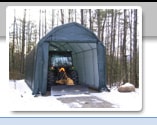For out door pets, horses and livestock browse our terrific selection of kennels, run-in sheds and hay storage shelters to keep animals and food stock safe from heavy wind, rain, snow, heat and other potentially damaging elements. Animals are used to the wild but damaging weather can lead to a host of problems including disease, heat stroke and frostbite. Protect your pets and farm animals with durable, portable shelters that are easy to set up, lightweight enough to transport and made to resist rain, wind and harmful UV rays. Our dog kennels feature polyethylene covers with UV treated material, added fade-blockers and anti-fungal agents so pets will be safe and secure.
These sturdy structures also include ¾” lift spacers, mesh wire grade steel frame and four point adjustable cover tie downs. Our run-in sheds are ideal for horses and feature steel tubing frames, fitted cover and white interior for ambient lighting. No drilling or field cutting is required. These shelters are great for protecting horses and other livestock from sudden storms and can also be used to store hay and other grasses.
So if you're looking for an easy-to-use and affordable way to protect your animals from the elements, a temporary portable shelter may be the perfect solution.
There are many benefits of using portable shelters over traditional permanent structures. One of the most common reasons to use these shelters is that they are easy to set up and dismantle, which makes them a great option if you need to move your animals' housing on a frequent basis. These shelters can be moved by one person in just minutes, which means that they can be used in almost any location. They also use fewer materials than traditional shelters, which means that they are less expensive to construct and maintain.
Another benefit of using temporary portable shelters is that they have a smaller environmental impact than permanent structures. Traditional permanent animal housing often requires large amounts of wood and other materials as well as heavy equipment such as tractors or bulldozers in order to build it correctly; this means that there is more waste generated during construction—and then more waste produced by maintaining traditional housing over time. In contrast, these temporary shelters require less material and no heavy machinery during construction; they also require less maintenance once they are built so there is less waste generated overall from both construction and maintenance processes over time.






